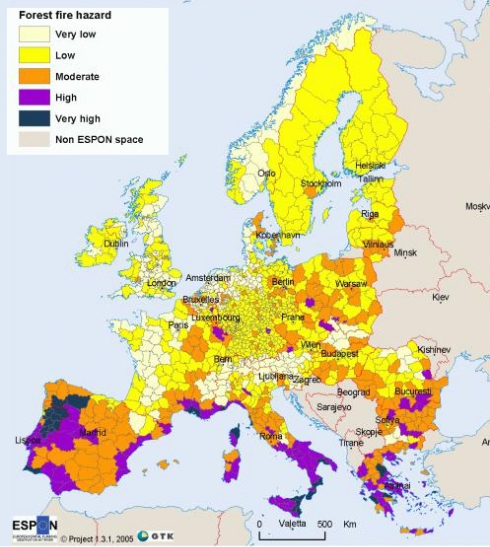In the past decade forest fires have received a lot of media attention due to their social impact. Forest fires (wild fires) cause considerable environmental damage as well as human casualties. Forest fires also have a considerable impact on the economy as they have huge implications for forestry, infrastructure and private property.
Forest fires are natural phenomena (being ignited by lightning, for example) and are important for a forest's natural life cycle as dead wood is burnt.

Figure 1.1 reveals the severity of the forest fires in the Balkans during the summer of 2007. The image shows a large area with ash clouds on a day with many active fires. In Greece in particular the situation was dramatic as wild fires claimed the lives of 68 people and 269.114 hectares of land were destroyed.
Wild fires occur over the entire planet but they seem to be more common in certain areas and are bound to seasonal variation. The forest fire hazard map (Fig. 1.2) shows that the areas with the highest potential for forest fires (in Europe) lie in the Mediterranean, parts of Romania and Bulgaria and in some hot spots in Central Europe.

A forest fire is a complex phenomenon that is difficult to model and manage. There are many factors that contribute to the ignition and spread of forest fires, such as human factors, topographic variables, meteorological variables and vegetation variables.
The major problem is that a large number of forest fires are caused by human actions, for example arson, which is difficult to predict in any form. According to the Global Forest Fire Assessment, the proportion of forest fires caused by arson (the act of deliberately setting fire to a piece of property) reaches 90-95% in the Mediterranean basin, while natural causes represent only a small percentage of all fires (from one to five percent, depending on the country).
This training module is mainly for forecasters who deal in any way with forest fires. However, the module may be useful for other experts dealing with forest fires, such as civil protection agents, firemen or foresters.
We will address all relevant variables by giving background information and testing your knowledge. Chapter 2 will focus on the weather patterns favorable to forest fires, thus only focusing on the meteorological point of view. Chapter 3 will emphasize other factors (apart from meteorology) that are relevant for forest fire spread, such as topography and fuel (vegetation). In Chapter 4 you will see how forest fires can be classified according to different criteria and we will take a look at some special examples. Chapter 5 will show you in detail how forest fires can be identified through remote sensing, namely through the detection of hot-spots, fire smoke and burned areas. Finally, in Chapter 6, you will find a list of references and suggested links, in case you want to know more about forest fires.
If you think you can contribute to this training module or you have suggestions or questions please feel free to contact us.
Nuno Moreira - IM, Portuguese Met. Service
Jarno Schipper - ZAMG, Austrian Met. Service